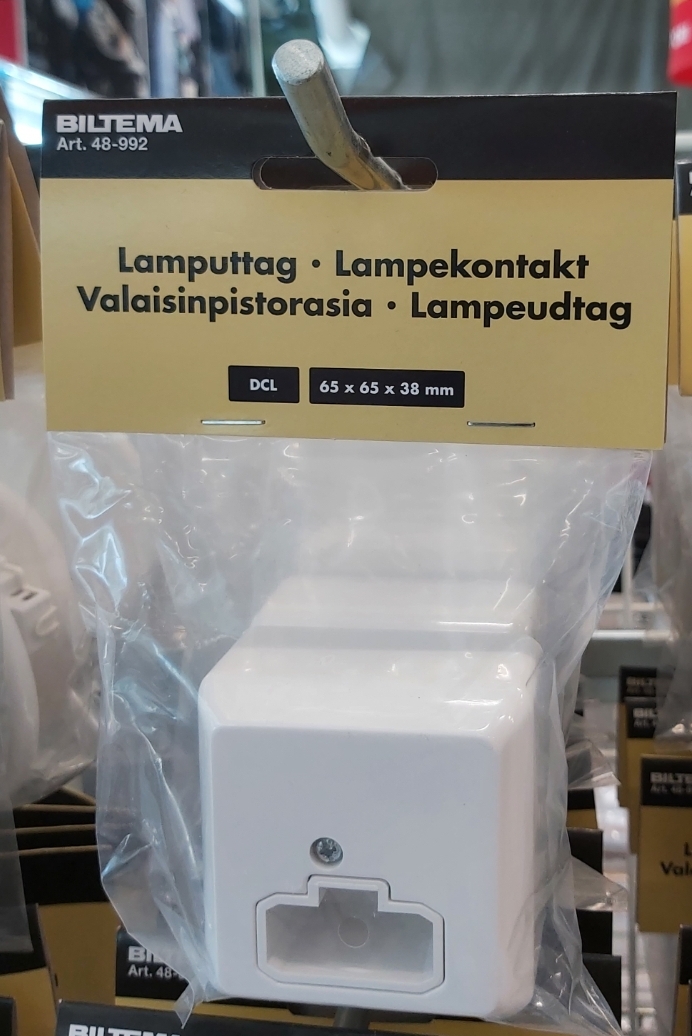European ceiling lights will start to use a common plug for easy installation. Device for Connection of Luminaires (DCL) is a European standard for ceiling light fixtures introduced in 2005 and refined in 2009. The history is longer.
The history of the common ceiling light plug goes longer. In Finnish apartments, for over thirty years, same type of lamp sockets as used in Sweden have been used to connect lamps. This “Swedish type lamp socket” served the needs quite well, however, the used lamp plug is quite large that can be difficult to fit it nicely inside the ceiling cups of the lamps.
Also in other parts of Europe, a need has been found for a similar plug-in switch intended for connecting a lamp, and therefore a new model has been developed, the so-called DCL lamp plug.
The use of these devices in new and renovated homes in France became mandatory in 2001 (Norme Française NF C 15-100). Identical DCL lamp sockets and plugs are used in Norway; compulsory in 2019 (images 11 and 12). From 2019 also Finland allows the use of DCL types, additional to the Swedish type of lamp plugs. This DCL socket is now also approved to use in many other European countries.
The DCL type system has only one type of socket with protective earthing contacts. There are two types of plugs, those equipped with protective grounding contacts and those intended for class II lamps, where the protective grounding contact is replaced by an insulating pin.
Since it is a global standard, in the future the lamps intended to be connected by the resident themselves will be equipped with this new plug. DCL sockets and plugs comply with IEC 61955 standard (SS-EN61995). DCL type lamp sockets are designed for ceiling mounting. They are rated at 6A – 250V. Pin contacts are deeply recessed (24.5 mm). Pins have a length of 7 mm (L and N) or 8 mm (earth) and are 2.8 mm wide and 0.8 mm thick. Plug fixation in the recessed outlet is ensured by a clip.
All lamp sockets have a lamp symbol and carry the CE marking as per the Low Voltage Directive. DCL socket is only allowed to be installed with ground.
The new DCL lamp socket is usually flush-mounted, so that the plug goes completely inside the recessed socket. The end result takes up little space and looks neat.
On the other hand, a recessed socket takes up space in the installation box and limits its use if the box above the lamp is full of wires. For this reason there are also sockets that are only partially recessed or flush mount versions.
Plug pinout:
Pin 1 Load L
Pin 2 Protective earth PE
Pin 3 Neutral N
The DCL outlet has always ground connection connected to ground wire.
The DCL plug is normally with a ground pin, but also using a DCL plug without ground connection is allowed with lights that are safe without ground connection (class 2). New lamps can come with the DCL plug. For lamps that do not come with DCL plug, you can screw in a DCL plug to lamp wires or use a DCL plug with short cable that connects to lamp.
Finland allows nopw the use of DCL types, additional to the Swedish type of lamp plugs. The light circuits that have those sockets for ceiling lights are typically protected with 10A breaker (1.5–2.5 mm2 group cable).
Sources:
https://en.wikipedia.org/wiki/Device_for_Connection_of_Luminaires
https://stek.fi/sahkoturvallisuus/sallitut-sahkotyot/valaisintulpan-asentaminen/
https://www.plugsocketmuseum.nl/LampSockets1.html


3 Comments
Jovany says:
I find it quite interesting. I have seen many types of sockets before but this one is very special. Thank you for sharing. papa’s games
Suyu says:
These are standardized electrical fittings used for connecting light fixtures in a safe and convenient manner.
Elmodoyle says:
Thank you. fnf mods